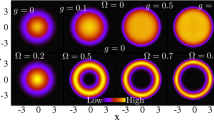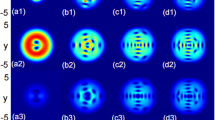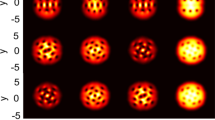Abstract
Vortices in a one-component dilute atomic ultracold Bose–Einstein condensate (BEC) usually arise as a response to externally driven rotation. Apart from a few special situations, these vortices are singly quantized with unit circulation (Fetter, Rev Mod Phys 81, 647–691, 2009). Recently, the NIST group has constructed a two-component BEC with a spin-orbit-coupled Hamiltonian involving Pauli matrices (Spielman, Phys Rev A 79, 063613, 2009; Y.-J. Lin et al., Nature 462, 628–632, 2009; Y.-J. Lin et al., Nature 471, 83–87, 2011), and I here study the dynamics of a two-component vortex in such a spin-orbit-coupled condensate. These spin-orbit-coupled BECs use an applied magnetic field to split the hyperfine levels. Hence, they rely on a focused laser beam to trap the atoms. In addition, two Raman laser beams create an effective (or synthetic) gauge potential. The resulting spin-orbit Hamiltonian is discussed in some detail. The various laser beams are fixed in the laboratory, so that it is not feasible to nucleate a vortex by an applied rotation that would need to rotate all the laser beams and the magnetic field. In a one-component BEC, a vortex can also be created by a thermal quench, starting from the normal state and suddenly cooling deep into the condensed state (Freilich et al., Science 329, 1182–1185, 2010). I propose that a similar method would work for a vortex in a spin-orbit-coupled BEC. Such a vortex has two components, and each has its own circulation quantum number (typically \(0,\pm 1\)). If both components have the same circulation, I find that the composite vortex should execute uniform precession, like that observed in a single-component BEC (Freilich et al., Science 329, 1182–1185, 2010). In contrast, if one component has unit circulation and the other has zero circulation, then some fraction of the dynamical vortex trajectories should eventually leave the condensate, providing clear experimental evidence for this unusual vortex structure. In the context of exciton–polariton condensates, such a vortex is known as a “half-quantum vortex” (Rubo, Phys Rev Lett 99, 106401, 2007; Lagoudakis et al., Science 326, 974–976, 2009).







Similar content being viewed by others
References
I.B. Spielman, Raman processes and effective gauge potentials. Phys. Rev. A 79, 063613 (2009)
Y.-J. Lin, R.L. Compton, K. Jiménez-García, J.V. Porto, I.B. Spielman, Synthetic magnetic fields for ultracold neutral atoms. Nature 462, 628–632 (2009)
Y.-J. Lin, K. Jiménez-García, I.B. Spielman, Spin-orbit-coupled Bose-Einstein condensates. Nature 471, 83–87 (2011)
A.L. Fetter, A.A. Svidzinsky, Vortices in a trapped dilute Bose-Einstein condensate. J. Phys. Condens. Matter 13, R135–R194 (2001)
A.L. Fetter, Rotating trapped Bose-Einstein condensates. Rev. Mod. Phys. 81, 647–691 (2009)
B.P. Anderson, P.C. Haljan, C.E. Wieman, E.A. Cornell, Vortex precession in Bose-Einstein condensates: observations with filled and empty cores. Phys. Rev. Lett. 85, 2857 (2000)
D.V. Freilich, D.M. Bianchi, A.M. Kaufman, T.K. Langin, D.S. Hall, Real-time dynamics of single vortex lines and vortex dipoles in a Bose-Einstein condensate. Science 329, 1182–1185 (2010)
J. Radić, T.A. Sedrakyan, I.B. Spielman, V. Galitski, Vortices in spin-orbit coupled Bose-Einstein condensates. Phys. Rev. A 84, 063604 (2011)
A.L. Fetter, Vortex dynamics in spin-orbit coupled Bose-Einstein condensates. Phys. Rev. A 89, 023629 (2014)
Y.G. Rubo, Half vortices in exciton polariton condensates. Phys. Rev. Lett. 99, 106401 (2007)
K.G. Lagoudakis, T. Ostatnický, A.V. Kavokin, Y.G. Rubo, R. André, B. Deveaud-Plédran, Observation of half-quantum vortices in an exciton-polariton condensate. Science 326, 974–976 (2009)
J. Dalibard, F. Gerbier, G. Juzeliūnas, P. Öhberg, Colloquium: artificial gauge potentials for neutral atoms. Rev. Mod. Phys. 83, 1523–1543 (2011)
H. Zhai, Spin-orbit coupled quantum gases. Int. J. Mod. Phys. B 26, 1230001 (2012)
V. Galitski, I.B. Spielman, Spin-orbit coupling in quantum gases. Nature 494, 49–54 (2013)
N. Goldman, G. Juzeliūnas, P. Öhberg, I. B. Spielman, Light-induced gauge fields for ultracold atoms, arXiv:1308.6533v2 (2013)
H. Zhai, Degenerate quantum gases with spin-orbit coupling, arXiv:1403.8021v1 (2014)
J. Struck, C. Ölschläger, M. Weinberg, P. Hauke, J. Simonet, A. Eckardt, M. Lewenstein, K. Sengstock, P. Windpassinger, Tunable gauge potential for neutral and spinless particles in driven lattices. Phys. Rev. Lett. 108, 225304 (2012)
M. Aidelsburger, M. Atala, M. Lohse, J.T. Barreiro, B. Paredes, I. Bloch, Realization of the Hofstadter Hamiltonian with ultracold atoms in optical lattices. Phys. Rev. Lett. 111, 185301 (2013)
H. Miyake, G.A. Siviloglou, C.J. Kennedy, W.C. Burton, W. Ketterle, Realizing the Harper Hamiltonian with laser-assisted tunneling in optical lattices. Phys. Rev. Lett. 111, 185302 (2013)
G. Jotzu, M. Messer, R. Desbuquois, M. Lebrat, T. Uehlinger, D. Greif, T. Esslinger, Experimental realization of the topological Haldane model. Nature 515, 237–240 (2014)
M. Mancini, G. Pagano, G. Cappellini, L. Livi, M. Rider, J. Catani, C. Sias, P. Zoller, M. Inguscio, M. Dalmonte, L. Fallani, Observation of chiral edge states with neutral fermions in synthetic Hall ribbons, arXiv:1502.02495v1 (2015)
B. K. Stuhl, H.-I. Lu, L. M. Aycock, D. Genkina, and I. B. Spielman, Visualizing edge states with an atomic Bose gas in the quantum Hall regime, arXiv:1502.02496v1 (2015)
J. Jang, D.G. Ferguson, V. Vakaryuk, R. Budakian, S.B. Chung, P.M. Goldbart, Y. Maeno, Observation of half-height magnetization steps in Sr\(_2\)RuO\(_4\). Science 331, 186–188 (2011)
A. Ramanathan, S.R. Muniz, K.C. Wright, R.P. Anderson, W.D. Phillips, K. Helmerson, G.C. Campbell, Partial-transfer absorption imaging: a versatile technique for optimal imaging of ultracold gases. Rev. Sci. Instrum. 83, 083119 (2012)
Acknowledgments
Part of this article was written during a visit to the Institute for Advanced Study, Tsinghua University, Beijing, and I am grateful to T.-L. Ho and H. Zhai for their hospitality. I thank W. Zheng for a valuable discussion concerning the interpretation of the synthetic electric field in Fig. 2. I. Spielman and D. Hall have provided copies of some of their figures, and I thank them for their assistance. I am grateful to G.-Q. Liu and D. W. Snoke for discussions of the half-quantum vortices in exciton–polariton condensates.
Author information
Authors and Affiliations
Corresponding author
Rights and permissions
About this article
Cite this article
Fetter, A.L. Vortex Dynamics in a Spin-Orbit-Coupled Bose-Einstein Condensate. J Low Temp Phys 180, 37–52 (2015). https://doi.org/10.1007/s10909-015-1294-x
Received:
Accepted:
Published:
Issue Date:
DOI: https://doi.org/10.1007/s10909-015-1294-x




